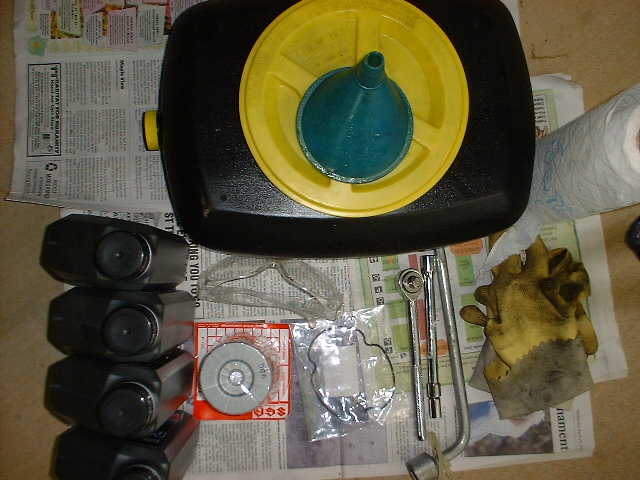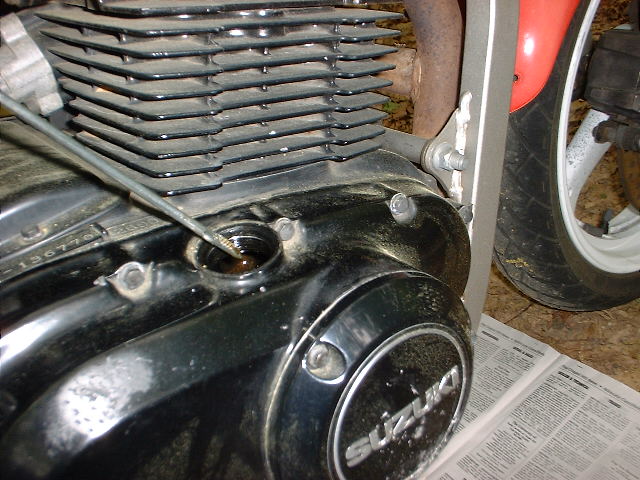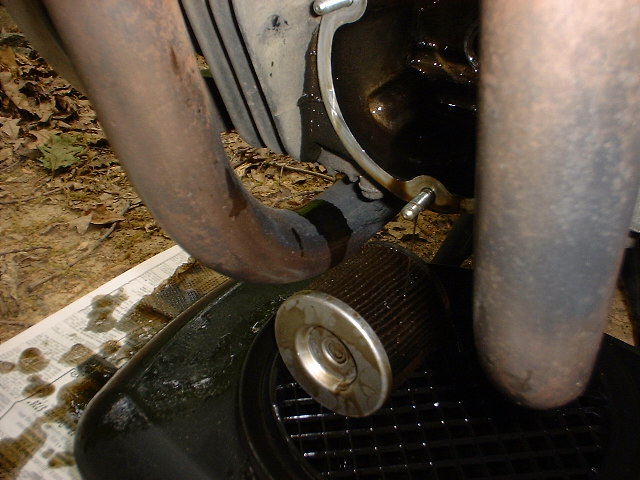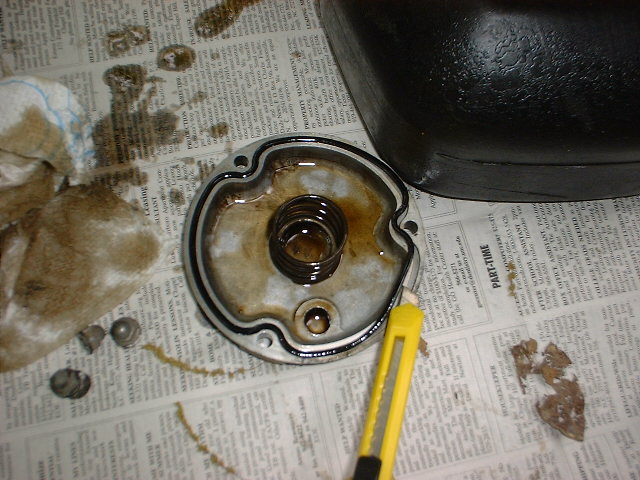 |
Ingredients:
-
Your favorite GS500E.
-
Oil pan.
-
Funnel.
-
21mm socket. I didn't have one handy, so
I used the wrench for the wheel nuts of my car. Worked great. A 3/8" spark plug socket will work as well. Luc says that his 2000 California model had a 17mm plug, so check before buying the tool.
-
10 mm socket with extension.
-
Racket wrench or equivalent.
-
Rubber gloves. Your wife's kitchen gloves are perfect, but that's your idea, not mine. Greg G. suggests using Mechanix gloves or something similar to avoid burns
-
Safety goggles.
-
3 quarts of 4-stroke motorcycle oil. I bought 4 to be safe, but 3 are enough.
-
Newspapers or carboard to catch spills.
-
Paper towels (not-so-optional if you are clumsy as I am.)
-
Oil filter (optional.). You can find it at auto parts stores. Part numbers for aftermarket filters are:STP SMO 00, FRAM CH6000, Purolator ML16800, Wix 24931 (thanks to JP for most of these numbers.)
-
O-ring for oil filter cover (optional.) Come already with some aftermarket filters.
-
O-ring for oil dip stick (optional.)
-
Aluminum washer (optional.)
-
Anti-seize compound (optional.)
-
30-40 min of your time.
|
 |
Put the bike on the centerstand on a plain area. Spread newpapers under
the engine to catch oil spills, and position the oil pan under the the
oil drain plug. |
 |
While the bike is still cold, loosen the bolts on the oil filter cover
with the 10 mm socket just enough that you don't have to struggle later
when the bike is hot. You really don't want to put your hands there
and fight the bolts when the pipes are hot. Make sure that the oil does
not leak out at this point though. |
 |
Wear gloves and safety goggles.
As above, loosen just a bit the oil drain plug located under the engine
with the 21mm socket. Again, make sure there are no oil leaks.
This picture was taken at the end, so you see oil everywhere. Sorry
for the bad quality, both hands were busy.
Now start the engine and warm it up for about 5 min so that the oil
will flow out easily.
Stop the engine and let the pipes cool down for a few minutes. |
 |
Unscrew the dip stick on the left of the engine and leave it off. Check the o-ring on the cap. Replace if broken or brittle. |
 |
Now remove completely the oil drain plug from under the engine and
let the oil flow into the pan. If you are smarter then I am, you won't
smear oil on the pipe. Oil vapors smell bad :( |
 |
Remove the lower nut on the filter cover first. That will make the
oil flow out into the oil pan. If you remove the lateral ones first, the
oil will flow onto the pipes. Don't ask how I found out :( |
 |
Remove the oil filter cover and expose the filter. |
 |
Remove the filter and let it drain on the oil pan for a while.
Clean out the dirt in the interior of the filter casing with paper towels. |
 |
Suzuki suggest to replace the o-ring at every oil change. I think you
can keep the old one as long as it is in good shape and there are no leaks.
If you decide to replace it, remove the old one with a knife, smear some fresh oil on the new one with a finger, and fit it in place.
|
 |
You should also replace the crusher washer on the drain plug. I dind't
have one, so I left in the old one. Besides it's really hard to take it
off. |
 |
Fit the new filter. The hole goes towards the engine.
Suzuki suggests replacing the filter at every oil change. Everyone has his/her own opinion on whether and when it's best to replace it. My opinion is that if the old filter is not too dirty, you can keep it. If you want to have peace of mind, replace it. |
 |
(Optional) Use anti-size compund on the thread of the nuts of the oil filter cover
so that you can remove them easily next time.
Close all the bolts and the drain plug. DO NOT OVERTIGHTEN since the bolts are prone to breaking, and close
each nut a little at a time until tight. |
 |
Suzuki suggests 10W40. The weight you need to use depends on your driving condition. If you drive a lot in slow traffic or see the redline regularly, you may want to use a heavier oil. If instead penguins are your riding mates, you
might want to use a lighter oil.
I used Mobil1 10W40, fully synthetic, mainly because I am very satisfied
with Mobil1 on my car.
Pour about 2.5 quarts of oil in the cranckcase. Make sure the funnel
is clean before doing that. You don't want any dirt travelling around in your engine.
Check the oil with the dip stick. Add more if necessary.
The oil is read without screwing the stick in, just drop it on the
casing and let it rest there.
The owner's manual says it holds 3 quarts. I used about 2.8.
Screw the dipstick in and run the engine for 2-3 min at idle. Drwebb suggests turning off the safety switch and clicking the starter 2-3 short bursts until the oil pressure light goes out to prime the oil filter first.
Check the oil level again and add more if necessary.
When done, make sure all bolts and screws are well tight, clean up everything
and bring the old oil and oil filter to a recycling center. Please do not
throw the oil into a drain or into the soil as it is very polluting. Also,
do not put the rubber gloves back in your kitchen: motor oil does not mix
well with food.
Feel good about yourself, but drink that beer you have in the fridge only after you GO FOR A RIDE.
After a few miles, check the oil level again and top off if necessary.
Now you can drink that beer.
|